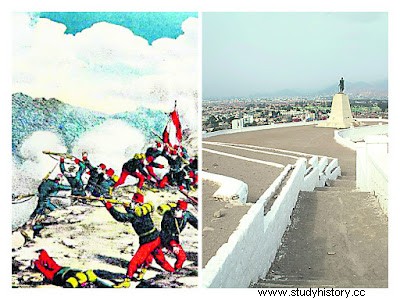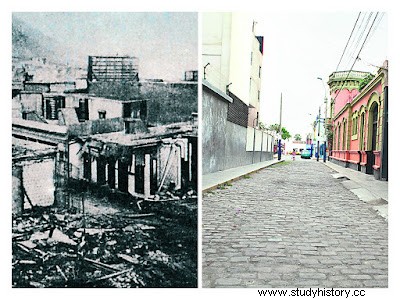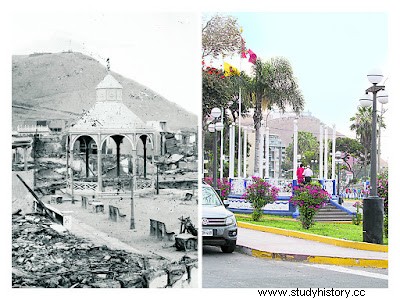TRAINS OF THE WAR. And although, indeed, it sounds like a Hollywood movie, those days in the sands of San Juan and in the trenches of Miraflores four Peruvians fought who in the following years would become presidents. Nicolás de Piérola was the current ruler at the time, after overthrowing Mariano Ignacio Prado in the middle of the conflict, becoming a dictator. The other three, Army officers, fought against the invader. Miguel Iglesias fought in San Juan defending the Santa Teresa hill and Marcavilca. The man from Cajamarca was head of the I Corps of the Army, and that January 13, 1881 he fought from five in the morning throughout the area located where the Atocongo station and the National Police cemetery are today. After noon, his lines being exceeded, he retreated with the rest of his men towards Morro Solar. The defense there was so tight that many Chilean sources treat Chorrillos as a separate battle, independent of what happened in San Juan. Less than a third of his 5,200 men remained at this point in the fight. The streets of Surco today bear the names of some of the battalions that fought under his command, such as the Tarma Battalion, the Cajamarca Battalion, the Callao Battalion and the Trujillo Free Battalion, the latter highlighted a few months ago in the news because it was where Rodolfo Orellana had his home. . In the Morro you can still see the bronze plaque at the point where the 500-pound Rodman howitzer manned by Chotano lieutenant David León was installed. The redoubt sustained the assault of the Melipilla and Coquimbo battalions, while being punished by the Chilean squad, which included the Huáscar monitor, already repaired after being captured in Angamos. At the top, Major Alejandro Iglesias dies in combat, who would not see his father become the Chilean post-occupation president of Peru.

LOOTING AND DESTRUCTION. In that same combat, Guillermo Billinghurst, at the time chief of the General Staff of the Army of the North, was also taken prisoner. According to Jorge Basadre's work, Iglesias, Billinghurst and other high officials were lined up in front of a wall to be shot. At that moment, the officer revealed the high rank of those present, so the sergeant who commanded the execution squad understood that they were worth more alive than with a bullet in the chest. Not everyone had the same luck. During the afternoon and night the Chilean troops, deaf to the call of their chiefs, set fire to the resorts of Chorrillos and Barranco in search of loot. Farms and ranches of the Lima aristocracy and wealthy foreign merchants were looted and destroyed, while their occupants were murdered and harassed. Accusing them of being mercenary soldiers, he shot them in San Pedro Park. They were all members of the Garibaldi bomb that still operates in Chorrillos. One of them, Luca Chiape, was only 17 years old at the time of his immolation. Another young man was also about to go down in history with his sacrifice. With the line army devastated on the 13th in San Juan and Chorrillos, the citizen militia remained in the redoubts or trenches of Miraflores. Armed neighbors who combined with the remnants of the regular troops. Among these neighbors were the students of Colegio Guadalupe, whose teachers often acted as their officers. It is in their honor that the monument to Los Cabitos, as these students were called, was erected in the Higuereta oval. One of them was Manuel Bonilla -the Miraflores stadium was named after him- 15 years old. age. Witnesses to the incident report that while he was helping to carry ammunition to the combatants at the foot of Redoubt No. 3, near what is now the Las Palmas Air Base, Colonel Narciso de La Colina climbed to the parapet to encourage his troops. dying instantly. Bonilla saw this and ran to pick up his rifle and continue firing on the enemy, but the explosion of a grenade killed him. Possibly the explosion was heard as far as Redoubt No. For neighboring merchants of the city, was Augusto B. Leguía, who fought all afternoon as a sergeant of a company of civilian volunteers. He survived to be president twice, the last known as the Oncenio de Leguía, between 1919 and 1930.

THE “WITCH” CÁCERES. But there were also some career soldiers in command of the last remnants of the regular army. Between the spaces left between the fortifications of the redoubts, the survivors of San Juan defended the passage towards Lima. In the space of Redoubts 1 and 2 was Colonel Andrés A. Cáceres, who led -among others- the Zepita and Ayacucho battalions with their characteristic white uniforms and light blue collars.Tradition says that Cáceres commanded these troops he charged with the bayonet managing to capture four field guns from his adversary. During the confrontation, a shot wounds him in the leg, for which he must be evacuated from the battlefield. After spending four months hidden in a convent until his wounds healed, he took the road to Chosica to start the Breña campaign in the mountains. Cáceres would defeat up to five times the expeditionary troops that were sent to destroy it for more than a year. His expertise not only gave him the title of "Wizard of the Andes", but the fame of never having surrendered to the enemy paved the way for him to also become President of the Republic between 1886 and 1890. Five men who, without meaning to, perhaps fighting side by side -except in the case of Piérola- in San Juan, Chorrillos, Barranco and Miraflores, they held the highest position in the Nation. A story that, incredibly, hardly anyone remembers.

